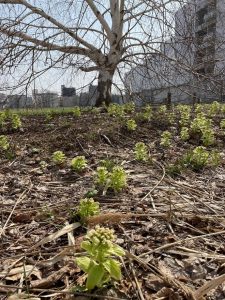Memoir (16) by Professor Joe Watkins, University of Arizona, USA
Yes, here in Hokkaido the snow has finally disappeared, although there are a few clumps and menacing-looking bergs here and there where the sun hasn’t been able to penetrate the shadows. Mud abounds, but it is nice not to have to bundle up against the biting, icy particles thrown around by the wind.
One of the first indications of spring here are the butterburs (petasites japonicus) – bits of green that look somewhat like a cross between cabbage and white broccoli or maybe cauliflower heads (though not quite as solid as the cauliflower heads). Known as fuki here, the plants are edible with proper preparation. The plant contains alkaloids that can be detrimental to one’s health, although those are primarily in the roots or rhizomes. Young stalks and buds can be eaten without too much advanced preparation, and a colleague commented that the young leaves could be boiled much like cabbage.
John Batchelor (“Edible plants of the Ainu” from Ainu Economic Plants by John Batchelor and Kingo Miyabe, 1893) said the Ainu used the flower shoot (makayo) and the stalk (korokoni) for food. He also said the Ainu once believed that “little people” used the giant leaves as the roofs of their houses and would stay dry in the rain by standing under the leaves.
Even though I am tempted to eat the plant, I doubt that I will. Still, it is good to know that it is more than just a sprig of green after a long, white winter.




